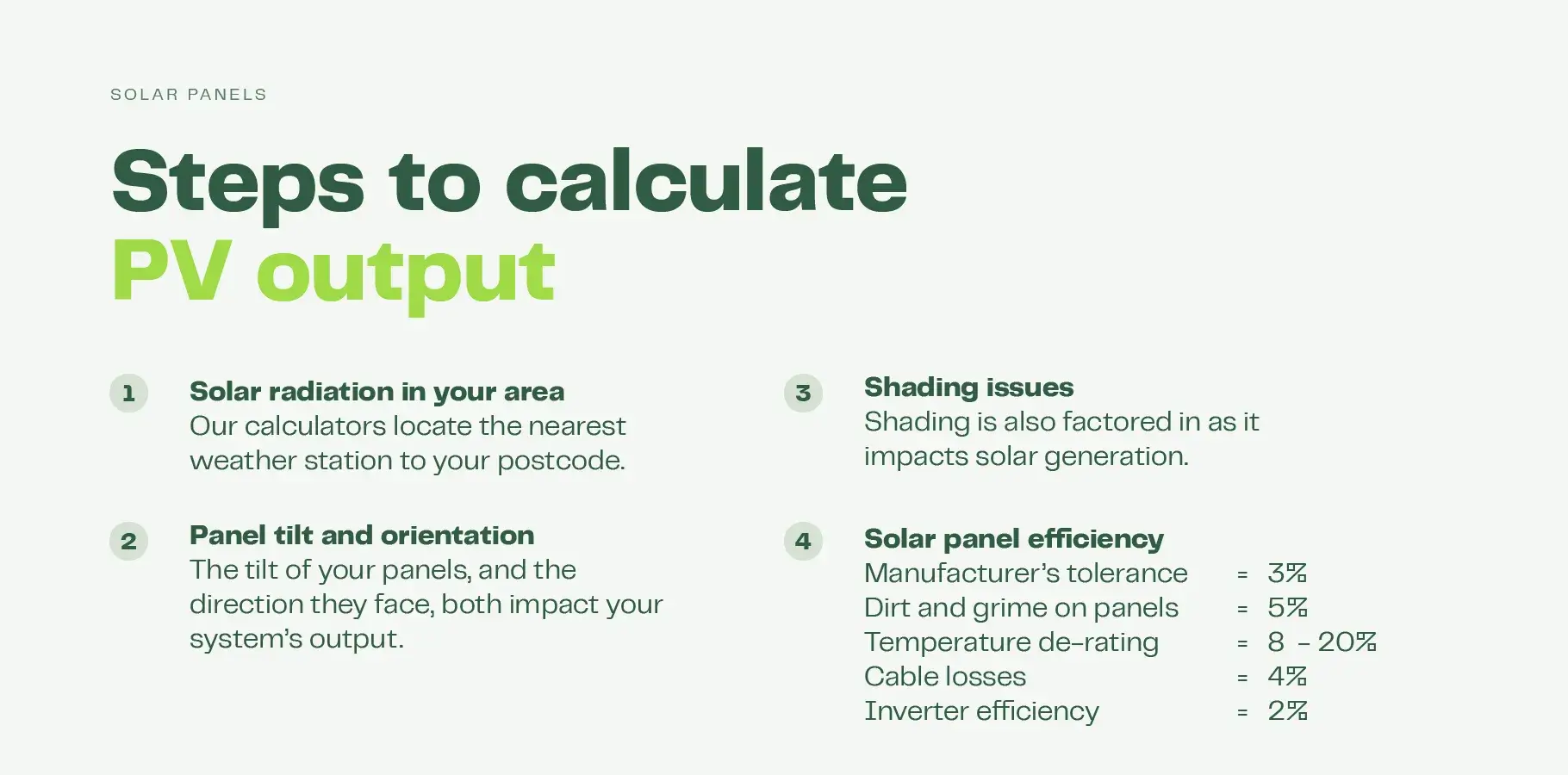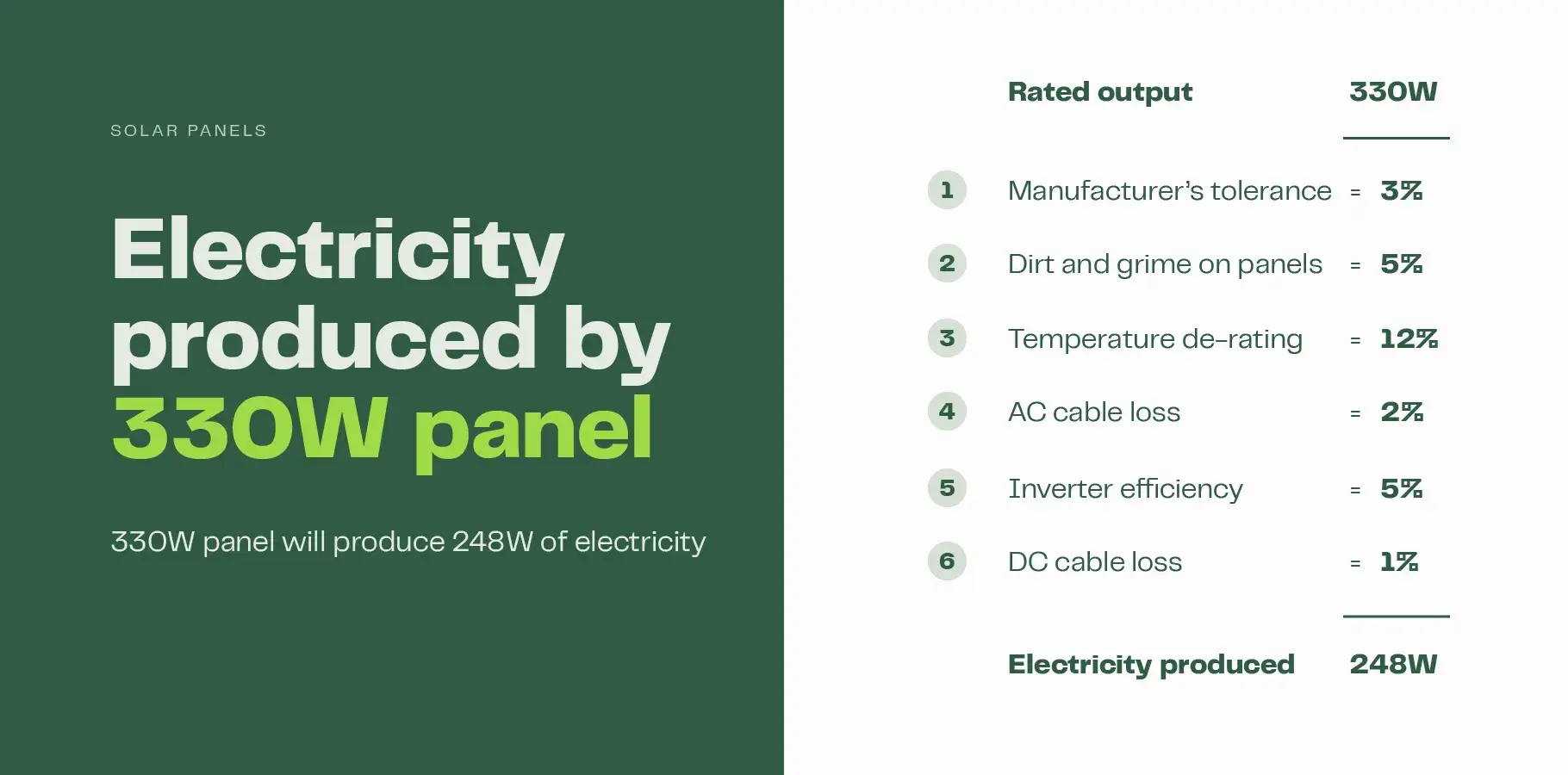Photovoltaic output of solar panels
Reading time: 5 minutes

Converting the rated Wattage of a solar panel into electricity to find its photovoltaic (PV) output, is essential in order to weigh up the feasibility of solar power. There are many inputs and variables required to calculate how much electricity solar panels generate; and each must be considered before the power output of a solar panel system can be determined.
Solar panel output in major Australia cities
The Clean Energy Council has provided the above figures to be used as a guide for the average daily production of various sized solar systems in major Australian cities. These figures take into account all of the factors that impact on the final output capability of a solar panel system.
Average daily solar output in major Australian cities
| Sydney | Melbourne | Perth | Brisbane | Hobart | Adelaide | Darwin | |
|---|---|---|---|---|---|---|---|
| 3kW system | 11.7 kWh | 10.6 kWh | 13.2 kWh | 12.6 kWh | 10.5 kWh | 12.6 kWh | 13.2 kWh |
| 5kW system | 19.5 kWh | 18.0 kWh | 22.0 kWh | 21.0 kWh | 17.5 kWh | 21.0 kWh | 22.0 kWh |
| 6.6kW system | 25.7 kWh | 23.8 kWh | 29.0 kWh | 27.7 kWh | 23.1 kWh | 27.7 kWh | 29.0 kWh |
| 10kW system | 39.0 kWh | 36.0 kWh | 44.0 kWh | 42.0 kWh | 35.0 kWh | 42.0 kWh | 44.0 kWh |
The figures in the table above are a very useful guide. However, they only represent the major Australian cities. Our calculators use data more specific to your location; when you key in your postcode, our database will draw on solar radiation data from the nearest weather station to your location. Then all of the other factors that affect solar output are applied to that data, including: roof tilt, orientation, shading, temperature derating and other inefficiencies. We cover each of these factors below.
Calculating electricity from solar panels
The steps below outline how the amount of electricity a solar system can produce is calculated. This same process is applied to the calculation of PV output that is used in our solar calculator.

Solar radiation data
The first step is to find a good source of solar radiation data for any given location. For Australia, we have used the Bureau of Meteorology’s Global Horizontal Irradiance (GHI) data that measures solar exposure per location in Mega Joule (MJ) units per m2. The GHI data combines both Direct Normal Irradiance (DNI) and Diffuse Horizontal Irradiance (DFI) measurements for various locations throughout Australia. Another method for calculating solar production is to use peak sunlight hour recordings for each location location.
Once we have the solar energy data for a given location, we then need to look at the specific elements of the building and property in question, that will have an affect on the final output of the system.
Roof tilt and orientation
The direction a solar panel array faces is important in calculating power output. In Australia, panels that face north perform best. However, the angle of the panels must also be considered along with the direction. To maximise year round solar production, panels should ideally be positioned at the latitude angle of the location. Any deviation from the optimal positioning of panels will result in lower output. Measurements for sunlight hitting panels at a specific tilt and orientation vary for different Australian cities.
Shading
If the panel array is affected by shading at any time during the day, then this will also impact the production capacity. How much so, will depend on whether or not the shading is completely blocking or just partially obscuring the suns rays; and for how long this occurs each day.
Solar radiation data, together with the property specific elements like: roof pitch, orientation and shading, all help determine the solar output possible at a given address. The efficiency of the solar panel also needs to be factored in before we are able to determine how much energy a panel is able to produce.
Factors that affect solar panel efficiency
There are factors that affect a solar panels ability to produce power up to its rated Wattage output. These are covered in great detail on this page. To summarise, the factors and average losses are listed below:
- Manufacturer’s output tolerance (+-3%)
- Dirt and grime on panels (5%)
- Temperature derating (8 - 20%)
- AC cable loss (2%)
- Inverter efficiency (5%)
- DC cable loss (1%)
Each of these efficiency losses and de-ratings are included in the calculation of output for a solar panel.
Electricity output of a typical solar panel
The infographic below shows the effect of efficiency factors on panel output; a panel rated at 250 Watts, will likely only produce 186.7W of electricity per hour of sunlight.


Are you ready for the benefits of solar?
Get 3 free quotes and start your journey towards making the switch.
Get free quotes